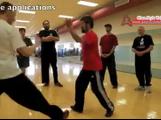 I’m writing this at about 30,000 feet on the plane from Munich, Germany to Toulouse, France. Master Chen Zhonghua is sitting next to me, it’s late evening and we are both tired from traveling shortly after noon.
I’m writing this at about 30,000 feet on the plane from Munich, Germany to Toulouse, France. Master Chen Zhonghua is sitting next to me, it’s late evening and we are both tired from traveling shortly after noon.
On the last flight, from Danzig, Poland to Munich Master Chen gave me another lesson about rotation.
Some of those ideas I had already heard on a flight almost two years ago, but what Master Chen taught me a few hours ago goes much, much further, of course. Some questions were answered, especially regarding applying the theory on the body.
The application cannot be written down, really. It must be demonstrated and felt. Trying do write it down will never do justice to the physical experience felt in person.
Here I would like to give a peek on the theory Master Chen taught me.
Let’s imagine a rotation disc. What impact does it have on us? First of all none. It can rotate slowly, fast or even not at all. Without a physical interaction it is absolutely irrelevant.
Let’s now assume it rotates at a slow speed. At some random point on the disc’s outer edge we attach a rope. This rope due to the slow rotation of the disc will be wrapped around it. For us in Taijiquan it has no function.
It get’s more interesting when the disc rotates at a higher number of revolutions. At a certain speed the outer end of the rope detaches from the disc. The relations between the number of revolutions per time, the radius of the disc and the length and mass of the rope is essential. Depending on the relations the rope can go straight and even stretch to a point where it breaks.
What does it mean to us? Where is the rope on the body?
Sitting in our seats on the plane and limited in space Master Chen explained and showed me the coherence of those variables. Other passengers around us gave us sneaking looks. They were curious what was going on.
“The rope doesn’t exist. It is just there to show us, that there is a evenly distributed forcefield around the rotating disc.” Master Chen answered my question. The forcefield exists as long as the disc is rotating and the mentioned relations are right.
How can I do that? How can I use it? Those were further questions by me. “You need a Catch!” Master Chen answered. He told me that the word for that kind of catch in the Chinese language has something to do with connecting pieces of wood by a carpenter. It’s like a clamp. You need to establish a clamp in order to rotate. Without a clamp there is no rotation. Looking at it from the other side: When you establish a clamp, you are rotating.
„Now you understand?“ — „Yes, Master Chen, I do.“
Es gibt eine deutsche Version auf der Seite von Practical Method Österreich.


